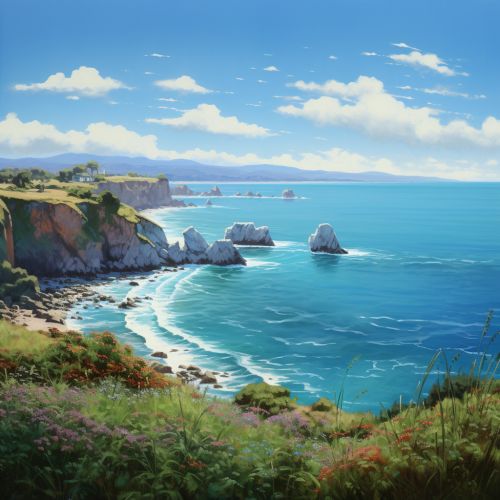Coastal Zones
Introduction
Coastal zones, also known as coastal areas, are regions where interaction of the sea and land processes occurs. These zones are significant as they host a variety of ecosystems, support a high level of biodiversity, and are home to a large proportion of the world's population. Coastal zones are dynamic environments with a constant change influenced by both terrestrial and marine factors.
Geographical Characteristics
Coastal zones are characterized by the presence of both terrestrial and marine features. They typically include the area from the shoreline, extending inland to where ocean-derived salts are detectable in the soil, and seaward to the outermost extent of the continental shelf.


Coastal Processes
Coastal zones are shaped by a combination of physical processes associated with waves, tides, and sediment transport. These processes are influenced by factors such as climate, topography, and human activity.
Waves
Waves are one of the most significant factors in shaping coastal zones. They are generated by wind blowing across the surface of the ocean, and their size and strength depend on the wind speed, its duration, and the distance over which it blows (the fetch).
Tides
Tides are the regular rise and fall of sea levels caused by the gravitational forces exerted by the Moon and the Sun and the rotation of the Earth. Tides can significantly influence coastal processes, particularly in areas with a large tidal range.
Sediment Transport
Sediment transport is a key process in the formation and change of coastal zones. It includes the erosion (or wearing away) of rocks and sediments, the transport of those materials, and their eventual deposition.
Coastal Ecosystems
Coastal zones host a variety of ecosystems, including coral reefs, Mangroves, salt marshes, and estuaries. These ecosystems are vital for their biodiversity, and they provide a range of ecosystem services that are crucial for human well-being.
Coral Reefs
Coral reefs are diverse underwater ecosystems held together by calcium carbonate structures secreted by corals. They are among the most biodiverse and productive ecosystems on Earth, supporting an extraordinary variety of marine species.
Mangroves
Mangroves are trees and shrubs that grow in saline coastal sediment habitats in the tropics and subtropics. They are highly productive ecosystems that provide numerous ecological services, including carbon sequestration, coastal protection, and habitat for a wide variety of species.
Salt Marshes
Salt marshes are coastal wetlands that are flooded and drained by salt water brought in by the tides. They are important habitats for many species and provide essential ecosystem services, including storm protection, flood control, and sediment stabilization.
Estuaries
Estuaries are partially enclosed coastal bodies of brackish water with one or more rivers or streams flowing into them and with a free connection to the open sea. They serve as important nursery areas for many marine and bird species.
Human Interaction
Coastal zones are of significant importance to humans. They provide a range of resources and services, including food, recreation, and tourism opportunities, and they are home to a large proportion of the world's population. However, human activities can also have significant impacts on coastal zones, leading to issues such as pollution, habitat loss, and climate change-induced sea-level rise.
